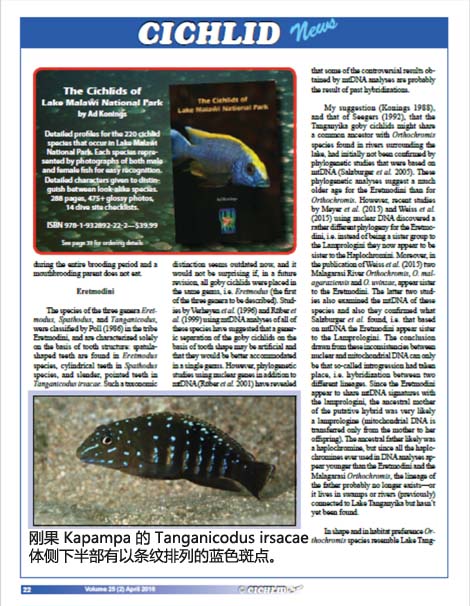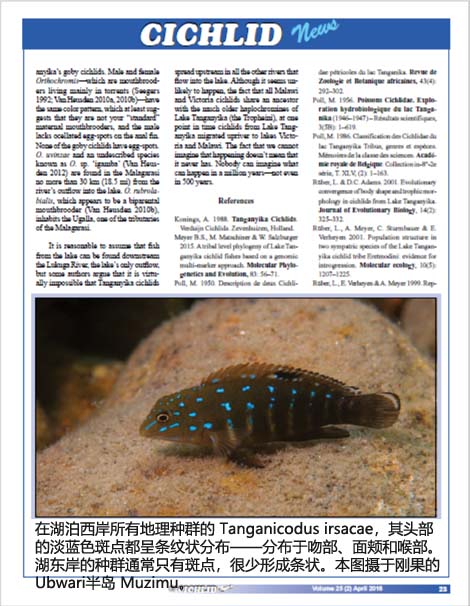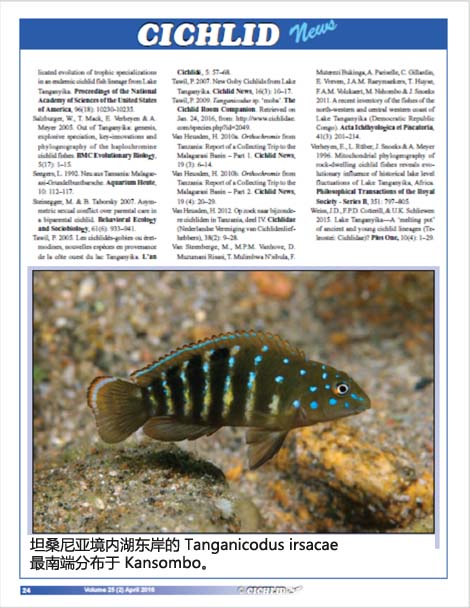|
Eretmodini 族
Poll(1986)将 Eretmodus、Spathodus 和 Tanganicodus 这三个属的物种归为 Eretmodini 族,仅依据其牙齿结构加以区分:Eretmodus 属为铲状齿,Spathodus 属为圆柱形齿,Tanganicodus irsacae 为细长尖锐齿。如今看来,这样的分类方式似显陈旧。若将来有人修订,将所有虾虎慈鲷都归入最早发表的 Eretmodus 属,也并不令人惊讶。Verheyen 等(1996)以及 Rüber 等(1999)对所有这些物种进行的线粒体DNA研究指出,仅凭牙齿形状区分虾虎慈鲷可能并不完全可靠,它们放在同一属里也许更合适。然而,随后利用核DNA和线粒体DNA综合分析的研究(Rüber 等 2001)表明,此前线粒体DNA 分析中的一些争议结果或许来源于过往的杂交事件。
我(Konings 1988)与 Seegers(1992)曾经推测,这些坦噶尼喀湖虾虎慈鲷可能与分布在湖周围河流的 Orthochromis 类群拥有共同祖先,但基于线粒体DNA 的系统发育研究(Salzburger 等 2005)最初并未证实这点。它们的分析结果暗示 Eretmodini 的起源比 Orthochromis 早得多。然而,Meyer 等(2015)以及 Weiss 等(2015)基于核DNA 的最新研究却得出了与前述不同的 Eretmodini 系统发育:它们不再与 Lamprologini 互为姐妹群,而与 Haplochromini 互为姐妹群。此外,在 Weiss 等(2015)的研究中,Malagarasi河流域的两种 Orthochromis(O. malagaraziensis 和 O. uvinzae)与 Eretmodini 互为姐妹群。这两项研究也检测了这些物种的线粒体DNA,结果再次证实 Salzburger 等的结论:基于线粒体DNA,Eretmodini 与 Lamprologini 互为姐妹群。核 DNA 与线粒体 DNA 得到的不同结果只能说明曾经存在所谓的“基因渗入”,即两个不同谱系之间发生了杂交。由于 Eretmodini 与 Lamprologini 共享线粒体DNA 特征,可推测假定杂交事件中的母本很可能是某个 lamprologine(线粒体DNA 只从母系遗传);而父本很可能属于某个 haplochromine。但由于目前所有被测试过的 haplochromine 都比 Eretmodini 和 Malagarasi 的Orthochromis 出现得更晚,所以“父系”这一分支可能已经灭绝,或者尚未在目前(或曾经)与坦噶尼喀湖相连的沼泽或河流中被发现。
在体型和栖息偏好上,Orthochromis 的一些物种确实与坦噶尼喀湖的虾虎慈鲷很相似。Orthochromis 的雌雄都是口孵者,主要生活在急流中(Seegers 1992;Van Heusden 2010a, 2010b),它们雌雄体色相似,至少可以说明并非“典型”的母系单亲口孵,而且雄鱼在臀鳍上没有卵斑——虾虎慈鲷也没有卵斑。O. uvinzae 和一个未描述的 O. sp. 'igamba'(Van Heusden 2012)出现在 Malagarasi 距河口不到30公里(18.5英里)的水域;O. rubrolabialis 似乎是双亲口孵者(Van Heusden 2010b),生活在 Malagarasi 的支流 Ugalla 河里。
有些人认为,湖中的鱼可以随 Lukuga河(坦噶尼喀湖唯一的出水口)向下游扩散,但也有人认为湖中的慈鲷几乎不可能逆流进入所有注入湖泊的河流。虽然这看似不大可能,但鉴于马拉维湖和维多利亚湖的所有慈鲷都与坦噶尼喀湖更古老的 haplochromine(Tropheini)共享祖先,可以推断在某个历史时期,坦噶尼喀湖中的慈鲷确实曾经逆流而上,到达了维多利亚湖和马拉维湖。我们无法想象这种事是怎么发生的,但并不代表它从未发生。在上百万年的时间里,甚至仅仅几百年里,会发生什么是我们无法想象的。
【参考文献】
--Konings, A. 1988. Tanganyika Cichlids. Verduijn Cichlids. Zevenhuizen, Holland. Meyer B.S., M. Matschiner & W. Salzburger 2015. A tribal level phylogeny of Lake Tanganyika cichlid fishes based on a genomic multi-marker approach. Molecular Phylogenetics and Evolution, 83: 56-71.Poll, M. 1950. Description de deux Cichlidae pétricoles du lac Tanganika. Revue de Zoologie et Botanique africaines, 43(4): 292-302.
--Poll, M. 1956. Poissons Cichlidae. Exploration hydrobiologique du lac Tanganika (1946–1947)–Résultats scientifiques,3(5B): 1-619. --Poll, M. 1986. Classification des Cichlidae dulac Tanganyika Tribus, genres et espèces. Mémoires de la classe des sciences. Académie royale de Belgique. Collection in-8°-2e série, T. XLV, (2): 1-163.
--Rüber, L. & D.C. Adams. 2001. Evolutionary convergence of body shape and trophic morphology in cichlids from Lake Tanganyika. Journal of Evolutionary Biology, 14(2): 325-332.
--Rüber, L., A. Meyer, C. Sturmbauer & E. Verheyen 2001. Population structure in two sympatric species of the Lake Tanganyika cichlid tribe Eretmodini: evidence for introgression. Molecular ecology, 10(5): 1207-1225.
--Rüber, L., E. Verheyen & A. Meyer 1999. Replicated evolution of trophic specializations in an endemic cichlid fish lineage from Lake Tanganyika. Proceedings of the National Academy of Sciences of the United States of America, 96(18): 10230-10235.
--Salzburger, W., T. Mack, E. Verheyen & A.Meyer 2005. Out of Tanganyika: genesis, explosive speciation, key-innovations and phylogeography of the haplochromine cichlid fishes. BMC Evolutionary Biology,5(17): 1-15.
--Seegers, L. 1992. Neu aus Tansania: Malagarasi-Grundelbuntbarsche. Aquarium Heute,10: 112-117.
--Steinegger, M. & B. Taborsky 2007. Asymmetric sexual conflict over parental care in a biparental cichlid. Behavioral Ecology and Sociobiology, 61(6): 933-941.
--Tawil, P. 2005. Les cichlidés-gobies ou éretmodines, nouvelles espèces en provenance de la côte ouest du lac Tanganyika. L'an Cichlidé, 5: 57-68.
--Tawil, P. 2007. New Goby Cichlids from Lake Tanganyika. Cichlid News, 16(3): 10-17.
--Tawil, P. 2009. Tanganicodus sp. "moba'. The Cichlid Room Companion. Retrieved on Jan. 24, 2016, from: http://www.cichlidae. com/species.php?id=2049.
--Van Heusden, H. 2010a. Orthochromis fromTanzania: Report of a Collecting Trip to the Malagarasi Basin - Part 1. Cichlid News,19 (3): 6-14.
--Van Heusden, H. 2010b. Orthochromis fromTanzania: Report of a Collecting Trip to the Malagarasi Basin-Part 2. Cichlid News,19 (4): 20-29.
--Van Heusden, H. 2012. Op zoek naar bijzondere cichliden in Tanzania, deel IV. Cichlidae (Nederlandse Vereniging van Cichlidenlief-hebbers), 38(2): 9-28.
--Van Steenberge, M., M.P.M. Vanhove, D.Muzumani Risasi, T. Mulimbwa N'sibula, F. Muterezi Bukinga, A. Pariselle, C. Gillardin,E. Vreven, J.A.M. Raeymaekers, T. Huyse,F.A.M. Volckaert, M. Nshombo & J. Snoeks 2011. A recent inventory of the fishes of the north-western and central western coast of Lake Tanganyika (Democratic RepublicCongo). Acta Ichthyologica et Piscatoria,41(3): 201-214.
--Verheyen, E., L. Rüber, J. Snoeks &A. Meyer 1996. Mitochondrial phylogeography of rock-dwelling cichlid fishes reveals evolutionary influence of historical lake level fluctuations of Lake Tanganyika, Africa. Philosophical Transactions of the Royal Society - Series B, 351: 797-805.
--Weiss, J.D., F.P.D. Cotterill, &U.K. Schliewen 2015. Lake Tanganyika—A 'melting pot' of ancient and young cichlid lineages (Teleostei: Cichlidae)? Plos One, 10(4): 1-29.
|


